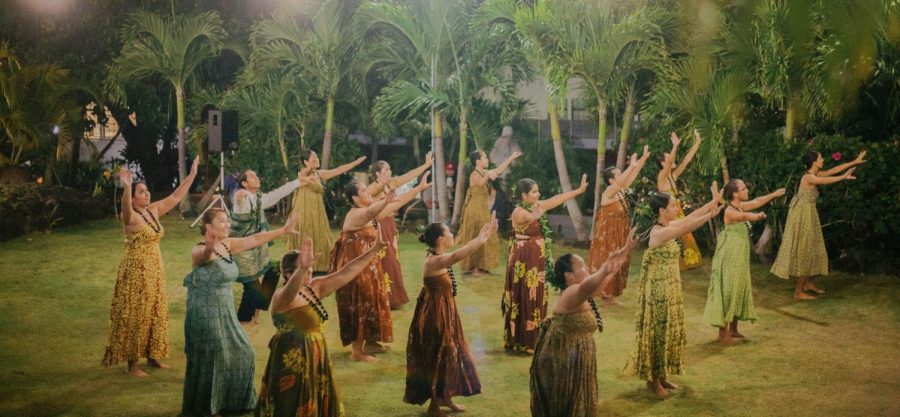Not even the rain could ‘dampen the mood’ during this year’s PIR
The Hawaiian Club at the Pacific Island Review
On Friday, Oct. 20, Chaminade University of Honolulu presented the 2017 Pacific Island Review. Friday was filled with dark clouds and rain that drizzled off and on. Despite the rain, the performers put on their best faces and took control of the stage.
“Initially the rain seemed to dampen the mood, but once we made it out there and started to move, I and some others felt an inherent emotion awaken,” said Alice Potter, a senior who has been dancing with the club since her freshman year. “We all got into the mood. We felt the dance went better than ever, with passion and excitement.”
To kick off the night, there was prayer before everyone partook in some local Hawaii food. A mixed salad, fish or chicken, rice and banana fruit flooded the plates of those that attended. Once everyone got their food, the rain started picking up.
Friends, families, and students filled the top row of the Sullivan Family Library. Chairs were lined up under palm trees while others found a spot on the rocks below, anticipating a great show and wanting the best seats in the house.
The first club to perform was the Hawaiian Club. They performed three dances. The first dance was all men. The guys were dressed in black pants and a white shirt with a green wrap and kukui nut leis. For the second performance, the women wore long floral dresses. Each performer danced with grace and pride. Although the tempo was slower for the first two performances, each person nailed their moves with intent. For the last performance by the Hawaiian Club, both the men and women performed to a more high tempo music choice.
“I think the Hawaiian Club reflected the heritage of the Hawaiian people. The combination of kahiko and auana was a good reflection of how it has adapted over time,” said Kristin Perreira, a 20-year-old of Chinese-Hawaiian descent.
A break in-between performances, led way to a speech in regards to the recent events occurring in Puerto Rico. A GoFundMe has been started to help the island rebuild. The athletic department has conducted a clothes drive and the Hogan Entrepreneurship program have raised $1,010.11 to go towards relief efforts after Hurricane Maria devastated the island. After a prayer for Puerto Rico was said, it was time to witness the Micronesian Club.
The Micronesian Club impressed the crowd by the banging of sticks and bright purple and orange attire. But the real wow factor was the fact that they danced in the rain. Despite the conditions, they continued to tell the story of a runaway princess.
A rare thing you see at performances, is the staff performing. Nine staff members from Chaminade dressed in black shirts and jeans took the stage. Everyone clapped and lit up with excitement to see staff participate in such an event. They hulaed their way into everyone’s hearts.
The Tahitian Club had a lot of luck, as the rain started to subside. The dancers graced the stage in red costumes that helped amp up the audience. The Tahitian Club is always a performance that people anticipate and look forward to. From every hip shake to each tribal stomp, their performance was one of great storytelling put into motion.
A clip was presented next to raise awareness on climate change. #HaveYourSei is meant to show why strong climate action is needed and how the Pacific is taking action to bring change.
Lastly, the Samoan Club ended the show with families and audience members fully participating. All the hand movements of the taupou were done in a subtle but delicate manner. Little kids along with staff and family members raced up to the stage and started throwing money at the taupou. According to a universal practice for modern Samoans, throwing money onto the floor or into the air above the dancer is an acknowledgment of her skill and status.
Many students join clubs to meet new people. “Initially I joined the club because I wanted something to do in my spare time freshman year,” Potter said. “Now I definitely have more friends, I am learning more about the Tahitian traditions, and feeling more integrated with the student body.”
